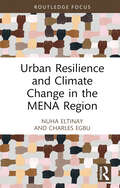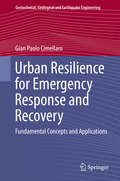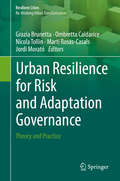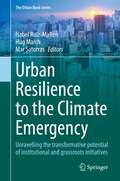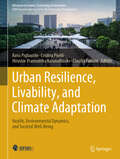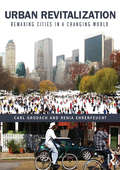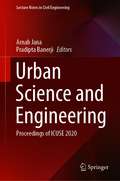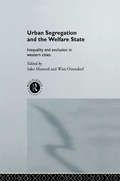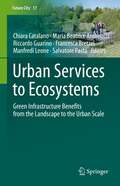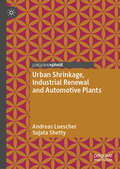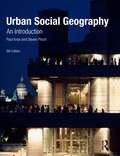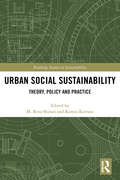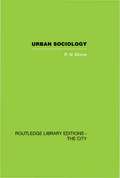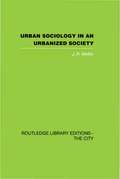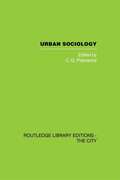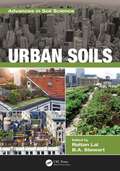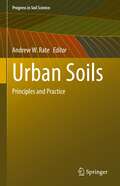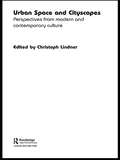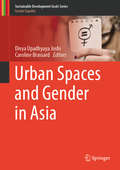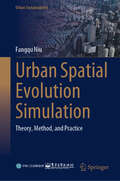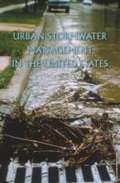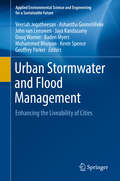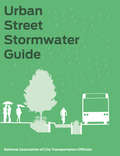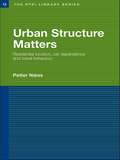- Table View
- List View
Urban Resilience and Climate Change in the MENA Region (Routledge Focus on Environment and Sustainability)
by Charles Egbu Nuha EltinayThis book provides an overview of the geopolitical context and climate change risk profile of the Middle East and North Africa (MENA) Region. Mapping existing scientific literature and key reports on MENA climate change impacts and future projections, Nuha Eltinay and Charles Egbu establish links between the Conference of the Parties (from COP26, COP27 to COP28) Glasgow–Sharm el-Sheikh Work Program for Progress on the Global Goal on Adaptation, and regional climate adaptation financing targets, national government investments, and human security in local case studies. They also address gaps in disaster risk reduction institutional governance for sustainable development in the region. The authors move beyond the existing theoretical understanding of urban resilience to investigate how it is being measured and assessed in MENA in alignment with the IPCC’s climate change adaptation indicators. Finally, they explore how disasters and conflict displacement vulnerabilities and fragility affecting the communities most in need are being measured and integrated into cities’ resilience action plans and national disaster risk policies. Providing guidance and policy recommendations based on empirical research and key stakeholder engagement observations, this book will be of great interest to students, scholars, and professionals who are researching and working in the areas of climate change, urban planning, and environmental policy and governance. As this book comes out just after the closure of The United Nations Climate Change Conference COP28 negotiations, it sets the scene for pre-COP regional context, and paves the way for researchers and practitioners to undertake post-COP28 key takeaways and multi-level government commitments into action, for better climate mitigation and adaptation investments, resilient and sustainable future for all.
Urban Resilience for Emergency Response and Recovery
by Gian Paolo CimellaroThis book introduces the concepts of Resilience-Based Design (RBD) as an extension of Performance-Based Design. It provides readers with a range of cutting-edge methodologies for evaluating resilience and clarifies the difference between resilience, vulnerability and sustainability. Initially, the book focuses on describing the different types of uncertainty that arise in the context of resilience evaluation. This is followed by an entire chapter dedicated to the analytical and experimental recovery functions. Then, starting from the definition of resilience provided by MCEER, an extension of the methodology is provided that introduces the seven dimensions of Community Resilience, summarized in the acronym PEOPLES. They are: Population and Demographics, Environmental/Ecosystem, Organized Governmental Services, Physical infrastructures, Lifestyle and Community Competence, Economic Development, and Socio-Cultural Capital. For each dimension, components and subcomponents are defined and the related indices are provided. Underlining the importance of the physical infrastructure dimension, the book provides several examples of applications for transportation, hydraulic, gas and power networks. The problem of interdependencies and the domino effect is also taken into account during the analysis. One of the book's closing chapters focuses on different methodologies for improving disaster preparedness and engineering mitigation strategies, while the last chapter describes the different computer platforms available on the market for evaluating Community Resilience. The book offers readers an extensive introduction to the concept of Resilience-Based Design, together with selected advanced applications for specialists. No prerequisite knowledge is needed in order to understand the book, and the Appendix offers valuable supplemental information on e. g. the probabilistic concepts. As such, the book offers a valuable resource for graduate students, young engineers and researchers who are interested in the topic, and can also be used as a supplementary text in graduate level Disaster Resilience courses.
Urban Resilience for Risk and Adaptation Governance: Theory and Practice (Resilient Cities)
by Grazia Brunetta Ombretta Caldarice Nicola Tollin Marti Rosas-Casals Jordi MoratóThis book brings together a series of theory and practice essays on risk management and adaptation in urban contexts within a resilient and multidimensional perspective. The book proposes a transversal approach with regard to the role of spatial planning in promoting and fostering risk management as well as institutions’ challenges for governing risk, particularly in relation to new forms of multi-level governance that may include stakeholders and citizen engagement. The different contributions focus on approaches, policies, and practices able to contrast risks in urban systems generating social inclusion, equity and participation through bottom-up governance forms and co-evolution principles. Case studies focus on lessons learned, as well as the potential and means for their replication and upscaling, also through capacity building and knowledge transfer. Among many other topics, the book explores difficulties encountered in, and creative solutions found, community and local experiences and capacities, organizational processes and integrative institutional, technical approaches to risk issue in cities.
Urban Resilience to the Climate Emergency: Unravelling the transformative potential of institutional and grassroots initiatives (The Urban Book Series)
by Isabel Ruiz-Mallén Hug March Mar SatorrasThis volume sheds light on urban resilience strategies in times of climate emergency and social and economic crisis by reflecting on related social vulnerabilities and inequalities within cities and showing the potential of participatory governance approaches for socio-environmental transformation. The book compiles critical research documenting the articulation of urban resilience strategies dealing with climatic changes, as well as the understanding of the unexpected implications of top-down resilience plans to address the impacts of climate change in cities, especially on the most vulnerable urban populations, and the transformative capacities of bottom-up and socially innovative resilience strategies. The book especially focuses on co-produced and grassroots transformative processes that are concerned with social equity in urban planning for climate change. Although several publications cover the topic of urban resilience, this book provides a more nuanced exploration of urban climate governance and citizen engagement in urban climate resilience policies through the lenses of political ecology, environmental justice and co-production. In this regard, the volume moves beyond the approach of multilevel urban climate governance by critically addressing the unexpected impacts of top-down strategies of urban resilience with the goal of expanding the reflection on citizen engagement. The book also explores the emerging possibilities behind the co-production of urban resilience as well as the critical role of grassroots and citizens in promoting such alternative strategies. While the primary target audience is scholars from different disciplines (e.g. geography, urban studies, planning, political ecology, architecture, urban sociology, environmental studies) focusing on urban resilience, the editors also aim to reach urban resilience practitioners from local, national and international organisations as well as environmental grassroots and climate activists.
Urban Resilience, Livability, and Climate Adaptation: Health, Environmental Dynamics, and Societal Well-Being (Advances in Science, Technology & Innovation)
by Cristina Piselli Claudia Fabiani Hirushie Pramuditha Karunathilake Ilaria PigliautileThis book explores urban environments and their impact on resilience, livability, climate adaptation, health, and societal well-being. It provides interdisciplinary insights for fostering resilient, livable, and sustainable cities prioritizing well-being and quality of life for all residents. The book covers various topics and discusses innovative approaches for incorporating nature into urban planning. It also examines the relationships between diet diversity, food environments, and transportation systems. Spatial analysis of noise contour maps based on traffic speed is conducted, along with an assessment of the impact of office environments on productivity. The book explores the influence of streetscapes on anxiety, envisions future cities from a youth perspective, and identifies critical factors affecting the design and use of elevated urban spaces. Daylighting performance in school expansions is evaluated, and the concept ofa livable city is examined. Community adaptive capacity for climate-resilient development is assessed through a case study analysis. The livability of street vendors in different urban contexts is compared, and alternative perspectives on restorative environments are presented. The book investigates the impact of urban refugees on cities and reevaluates scientific theories for human well-being-oriented built environments. It evaluates tourist satisfaction with urban railway systems and explores sport as a tool for healthy and sustainable cities.
Urban Revitalization: Remaking cities in a changing world
by Carl Grodach Renia EhrenfeuchtFollowing decades of neglect and decline, many US cities have undergone a dramatic renaissance. From New York to Nashville and Pittsburgh to Portland governments have implemented innovative redevelopment strategies to adapt to a globally integrated, post-industrial economy and cope with declining industries, tax bases, and populations. However, despite the prominence of new amenities in revitalized neighborhoods, spectacular architectural icons, and pedestrian friendly entertainment districts, the urban comeback has been highly uneven. Even thriving cities are defined by a bifurcated population of creative class professionals and a low-wage, low-skilled workforce. Many are home to diverse and thriving immigrant communities, but also contain economically and socially segregated neighborhoods. They have transformed high-profile central city brownfields, but many disadvantaged neighborhoods continue to grapple with abandoned and environmentally contaminated sites. As urban cores boom, inner-ring suburban areas increasingly face mounting problems, while other shrinking cities continue to wrestle with long-term decline. The Great Recession brought additional challenges to planning and development professionals and community organizations alike as they work to maintain successes and respond to new problems. It is crucial that students of urban revitalization recognize these challenges, their impacts on different populations, and the implications for crafting effective and equitable revitalization policy. Urban Revitalization: Remaking Cities in a Changing World will be a guide in this learning process. This textbook will be the first to comprehensively and critically synthesize the successful approaches and pressing challenges involved in urban revitalization. The book is divided into five sections. In the introductory section, we set the stage by providing a conceptual framework to understand urban revitalization that links a political economy perspective with an appreciation of socio-cultural factors in explaining urban change. Stemming from this, we will explain the significance of revitalization and present a summary of the key debates, issues and conflicts surrounding revitalization efforts. Section II will examine the historical causes for decline in central city and inner-ring suburban areas and shrinking cities and, building from the conceptual framework, discuss theory useful to explain the factors that shape contemporary revitalization initiatives and outcomes. Section III will introduce students to the analytical techniques and key data sources for urban revitalization planning. Section IV will provide an in-depth, criticaldiscussion of contemporary urban revitalization policies, strategies, and projects. This section will offer a rich set of case studies that contextualize key themes and strategic areas across a range of contexts including the urban core, central city neighborhoods, suburban areas, and shrinking cities. Lastly, Section V concludes by reflecting on the current state of urban revitalization planning and the emerging challenges the field must face in the future.Urban Revitalization will integrate academic and policy research with professional knowledge and techniques. Its key strength will be the combination of a critical examination of best practices and innovative approaches with an overview of the methods used to understand local situations and urban revitalization processes. A unique feature will be chapter-specific case studies of contemporary urban revitalization projects and questions geared toward generatingclassroom discussion around key issues. The book will be written in an accessible style and thoughtfully organized to provide graduate and upper-level undergraduate students with a comprehensive resource that will also serve as a reference guide for professionals
Urban Science and Engineering: Proceedings of ICUSE 2020 (Lecture Notes in Civil Engineering #121)
by Arnab Jana Pradipta BanerjiThis book comprises select proceedings of the First International Conference on Urban Science and Engineering. The focus of the conference was on the milieu of urban planning while applying technology which ensures better urban life, coupled with sensitivity to depleting natural resources and focus on sustainable development. The contents focus on sustainable infrastructure, mobility and planning, urban water and sanitization, green construction materials, optimization and innovation in structural design, and more. This book aims to provide up-to-date and authoritative knowledge from both industrial and academic worlds, sharing best practice in the field of urban science and engineering. This book is beneficial to students, researchers, and professionals working in the field of smart materials and sustainable development.^
Urban Segregation and the Welfare State: Inequality and Exclusion in Western Cities
by Sako Musterd Wim OstendorfUrban Segregation and the Welfare State examines ethnic and socio-economic segregation patterns, social polarisation, and social exclusion in major cities in the Western world. Contributors from across North America and Europe provide in-depth analysis of particular cities, ranging from Johannesburg, Chicago and Toronto to Amsterdam, Stockholm and Belfast. The authors highlight the social problems in and of cities, indicating differences between nation-states in terms of economic restructuring, migration, welfare state regimes and "ethnic history".
Urban Services to Ecosystems: Green Infrastructure Benefits from the Landscape to the Urban Scale (Future City #17)
by Maria Beatrice Andreucci Chiara Catalano Riccardo Guarino Francesca Bretzel Manfredi Leone Salvatore PastaThe aim of this book is to bring together multidisciplinary research in the field of green infrastructure design, construction and ecology. The main core of the volume is constituted by contributions dealing with green infrastructure, vegetation science, nature-based solutions and sustainable urban development. The green infrastructure and its ecosystem services, indeed, are gaining space in both political agendas and academic research. However, the attention is focused on the services that nature is giving for free to and for human health and survival. What if we start to see things from another perspective? Our actions shall converge for instance to turn man-made environment like cities from heterotrophic to autotrophic ecosystems. From landscape ecology to urban and building design, like bricks of a wall, from the small scale to the bigger landscape scale via ecological networks and corridors, we should start answering these questions: what are the services that are we offering to Nature? What are we improving? How to implement our actions? This book contains three Open Access chapters, which are licensed under the terms of the Creative Commons Attribution 4.0 International License (CC BY 4.0).
Urban Shrinkage, Industrial Renewal and Automotive Plants
by Andreas Luescher Sujata ShettyThis book focuses on the relationship between the auto industry and the built environment at multiple scales, a topic of particular interest now as the industry is going through a period of major transformation. Drawing from multiple perspectives, including architecture, urban design and urban planning, the authors examine the changing form of the auto factory itself, the changing geography of auto production, and the challenges faced by communities as the auto plants that once brought them prosperity, and often a sense of identity, leave town. They examine four places that are dealing in different ways, and with varying success, with the aftermath of a decommissioned auto plant in their midst. These are Janesville, Wisconsin, and Willow Run, Michigan, in the U.S., and Bochum, Germany, and Genk, Belgium, in Europe. Together these four cases provide some clues about what the future might look like for places that were once intimately connected with the manufacture of cars.
Urban Social Geography: An Introduction
by Paul Knox Steven PinchThe 6th edition of this highly respected text builds upon the successful structure, engaging writing style and clear presentation of previous editions. Examining urban social geography from a theoretical and historical perspective, it also explores how it has developed into the modern day. Taking account of recent critical work, whilst simultaneously presenting well established approaches to the subject, it ensures students are well-informed about all the issues. The result is a topical book that is clear and accessible for students
Urban Social Sustainability: Theory, Policy and Practice (Routledge Studies in Sustainability)
by Ramin Keivani M. ShiraziThis ground breaking volume raises radical critiques and proposes innovative solutions for social sustainability in the built environment. Urban Social Sustainability provides an in-depth insight into the discourse and argues that every urban intervention has a social sustainability dimension that needs to be taken into consideration, and incorporated into a comprehensive and cohesive ‘urban agenda’ that is built on three principles of recognition, integration, and monitoring. This should be achieved through a dialogical and reflexive process of decision-making. To achieve sustainable communities, social sustainability should form the basis of a constructive dialogue and be interlinked with other areas of sustainable development. This book underlines the urgency of approaching social sustainability as an urban agenda and goes on to make suggestions about its formulation. Urban Social Sustainability consists of original contributions from academics and experts within the field and explores the significance of social sustainability from different perspectives. Areas covered include urban policy, transportation and mobility, urban space and architectural form, housing, urban heritage, neighbourhood development, and urban governance. Drawing on case studies from a number of countries and world regions the book presents a multifaceted and interdisciplinary understanding from social sustainability in urban settings, and provides practitioners and policy makers with innovative recommendations to achieve more socially sustainable urban environment.
Urban Socio-Economic Segregation and Income Inequality: A Global Perspective (The Urban Book Series)
by Maarten Van Ham Tiit Tammaru Rūta Ubarevičienė Heleen JanssenThis open access book investigates the link between income inequality and socio-economic residential segregation in 24 large urban regions in Africa, Asia, Australia, Europe, North America, and South America. It offers a unique global overview of segregation trends based on case studies by local author teams. The book shows important global trends in segregation, and proposes a Global Segregation Thesis.Rising inequalities lead to rising levels of socio-economic segregation almost everywhere in the world. Levels of inequality and segregation are higher in cities in lower income countries, but the growth in inequality and segregation is faster in cities in high-income countries. This is causing convergence of segregation trends. Professionalisation of the workforce is leading to changing residential patterns. High-income workers are moving to city centres or to attractive coastal areas and gated communities, while poverty is increasingly suburbanising. As a result, the urban geography of inequality changes faster and is more pronounced than changes in segregation levels. Rising levels of inequality and segregation pose huge challenges for the future social sustainability of cities, as cities are no longer places of opportunities for all.
Urban Sociology
by R.N. MorrisThis book offers a coherant theoretical introduction to urban sociology. Based on the urban theory of Louis Wirth, it systematically examines Wirth's principal ideas in the contexts of pre-industrial cities, industrial cities and bureaucracies. Morris discusses conditions for the emergence of cities and for industrialization. He relates organisational and ecological accounts of the city and considers the contributions of each. Bureaucracy appears as a peculiarly urban form of organisation: its ecological and social characteristics are examined in an original manner and with considerable insight so as to illustrate and modify the propositions derived from Wirth's theory. The book concludes with a comprehensive evaluation of Wirth and his critics. This book was first published in 1968.
Urban Sociology and Urbanized Society (International Library Of Sociology)
by J.R. MellorFocusing on urban sociology as practised in Britain, the author argues that it is a key element in the response of the 'intellectual proletariat' to urbanization and the calls on it by the State to control the ensuing way of life. The themes of urban sociology have been the concerns of the Welfare State and, despite radical inputs, the discipline has remained tied up with the assumptions and methodological precepts of liberalism. The author's contention is that urbanization should be analysed in the framework of the political economy of regional development. This book was first published in 1977.
Urban Sociology: Critical Essays
by C. G. PickvanceThis book applies the historical materialist, or Marxist view of urban sociology and collates some fundamental sources of this perspective available. This book was first published in 1976.
Urban Soils (Advances in Soil Science)
by Rattan Lal B. A. StewartGlobally, 30% of the world population lived in urban areas in 1950, 54% in 2016 and 66% projected by 2050. The most urbanized regions include North America, Latin America, and Europe. Urban encroachment depletes soil carbon and the aboveground biomass carbon pools, enhancing the flux of carbon from soil and vegetation into the atmosphere. Thus, urbanization has exacerbated ecological and environmental problems. Urban soils are composed of geological material that has been drastically disturbed by anthropogenic activities and compromised their role in the production of food, aesthetics of residential areas, and pollutant dynamics. Properties of urban soils are normally not favorable to plant growth—the soils are contaminated by heavy metals and are compacted and sealed. Therefore, the quality of urban soils must be restored to make use of this valuable resource for delivery of essential ecosystem services (e.g., food, water and air quality, carbon sequestration, temperature moderation, biodiversity). Part of the Advances in Soil Sciences Series, Urban Soils explains properties of urban soils; assesses the effects of urbanization on the cycling of carbon, nitrogen, and water and the impacts of management of urban soils, soil restoration, urban agriculture, and food security; evaluates ecosystem services provisioned by urban soils, and describes synthetic and artificial soils.
Urban Soils: Principles and Practice (Progress in Soil Science)
by Andrew W. RateThis textbook addresses the increasing trend in urbanization of the world’s population and its relation with urban soils. Written by active practitioners of university level teaching and research, this book is designed primarily as an educational text, while it also provides readers with an authoritative gateway to the primary literature. It includes explicit coverage of spatial and statistical (multivariate) techniques and case studies to illustrate key concept, and to support practical guidance in issues such as data collection and analysis. The authors reflect current developments in research and urban trends. In China, for example, the proportion of the population living in cities increased from 13% in 1950 to 45% in 2010 (World Bank data). Australia is one of the world's top ten urbanised countries with population greater than ten million, with approximately 90% of its population living in cities, mainly along Australia's coast. The most rapidly urbanising populations are currently in nations of the African continent. Soils in urban areas have multiple functions which are becoming more valued by urban communities: soils supply water, nutrients and physical support for urban plant and animal communities (parks, reserves, gardens), and are becoming increasingly valued for growing food. Soils may be used for building foundations, or as building materials themselves. Urban hydrology relies on the existence of unsealed soils for aquifer protection and flood control. This volume presents the importance of urban ecosystems and the impacts of global change. It examines pedogenesis of urban soils: natural materials affected by urban phenomena, and natural processes acting on urban materials, including an examination of different climatic zones. There is a focus on soils formed on landfill, reclaimed land, dredge spoils as well as soil-related changes in urban geomorphology. There is plenty of discussion on urban soil as a source and sink as well as soil geochemistry and health. The book is intended primarily as a text for upper-level undergraduate, and postgraduate (Masters) students. It will also be invaluable as a resource for professionals such as researchers, environmental regulators, and environmental consultants.
Urban Space and Cityscapes: Perspectives from Modern and Contemporary Culture (Questioning Cities)
by Christoph LindnerFrom the verticals of New York, Hong Kong and Singapore to the sprawls of London, Paris and Jakarta, this interdisciplinary volume of new writing examines constructions, representations, imaginations and theorizations of 'cityscapes' in modern and contemporary culture. With specially-commissioned essays from the fields of cultural theory, architecture, film, literature, visual art and urban geography, it offers fresh insight into the increasingly complex relationship between urban space, cultural production and everyday life. This volume draws on critical urban studies and moves beyond familiar cultural representations of the city by considering urban planning and architecture. Organized under three inter-related themes - image, text and form - essay topics range from the examination of cyberpunk skylines, pagan urbanism and the cinema of urban disaster, to the analysis of iconic city landmarks such as the twin towers, the London Eye and the Judisches Museum Berlin. Covering a diverse range of cities, including Berlin, Chicago, Jakarta, Johannesburg, Hong Kong, London, Los Angeles, Paris, and Venice, this fantastic resource for students, scholars and researchers alike, works expertly at the intersections of visual, material, and literary culture.
Urban Spaces and Gender in Asia (Sustainable Development Goals Series)
by Caroline Brassard Divya Upadhyaya JoshiExploring the relationship between place and identity, this book gathers 30 papers that highlight experiences from throughout the Asia-Pacific region. The countries profiled include China, India, Japan, Indonesia, and Thailand. Readers will gain a better understanding of how urbanization is affecting gender equity in Asian-Pacific cities in the 21st century. The contributing authors examine the practical implications of urban development and link them with the broader perspective of urban ecology. They consider how visceral experiences connect with structural and discursive spheres. Further, they investigate how multiple, interconnected relations of power shape gender (in)equity in urban ecologies, and address such issues as construction of Kawaii as an idealized femininity, diversity among homosexuals in urban India, and single women and rental housing. In turn, the authors present hitherto unexplored sub-themes from historiography and existentialist literary perspectives, and share a vast range of multi-disciplinary views on issues concerning gendered dispossession due to the impact of urban policy and governance. The topics covered include socio-spatial and ethnic segregation in urban spaces; intersections of gender, race, ethnicity, nationality, religion, and caste in urban spaces; and identity-based marginalization, including that of LGBT groups. Overall, the book brings together perspectives from the humanities and the social sciences, and represents a valuable contribution to the vital theoretical and practical debates on urbanism and gender equity.
Urban Spatial Evolution Simulation: Theory, Method, and Practice (Urban Sustainability)
by Fangqu NiuThis book provides a comprehensive introduction to the LUTI model from many aspects such as principles, methods and practice. Since the geometric revolution in the 1960s, model simulation methods have been used in some developed countries to study the development process of urban space and to support urban spatial decision making. One of the most common models is the Land Use Transport Interaction (LUTI) model. At present, relevant research is also gradually emerging in developing countries. This book has the following features: 1. The theory and methods of urban spatial development simulation have been systematically summarised, and practical application research has been carried out. 2. The LUTI model has been systematically explored from theory and implementation method to application practice. 3. The "activity-based" modelling techniques used are at the forefront of LUTI model development.
Urban Stormwater Management In The United States
by National Research Council of the National AcademiesThe rapid conversion of land to urban and suburban areas has profoundly altered how water flows during and following storm events, putting higher volumes of water and more pollutants into the nation's rivers, lakes, and estuaries. These changes have degraded water quality and habitat in virtually every urban stream system. The Clean Water Act regulatory framework for addressing sewage and industrial wastes is not well suited to the more difficult problem of stormwater discharges. This book calls for an entirely new permitting structure that would put authority and accountability for stormwater discharges at the municipal level. A number of additional actions, such as conserving natural areas, reducing hard surface cover (e.g., roads and parking lots), and retrofitting urban areas with features that hold and treat stormwater, are recommended.
Urban Stormwater and Flood Management: Enhancing the Liveability of Cities (Applied Environmental Science and Engineering for a Sustainable Future)
by Geoffrey Parker Ashantha Goonetilleke Veeriah Jegatheesan John Van Leeuwen Jaya Kandasamy Doug Warner Baden Myers Muhammed Bhuiyan Kevin SpenceThis book brings together the experiences of engineers and scientists from Australia and the United Kingdom providing the current status on the management of stormwater and flooding in urban areas and suggesting ways forward. It forms a basis for the development of a framework for the implementation of integrated and optimised storm water management strategies and aims to mitigate the adverse impacts of the expanding urban water footprint. Among other topics it also features management styles of stormwater and flooding and describes biodiversity and ecosystem services in relation to the management of stormwater and the mitigation of floods. Furthermore, it places an emphasis on sustainable storm water management measures. Population growth, urbanisation and climate change will pose significant challenges to engineers, scientists, medical practitioners, policy makers and practitioners of several other disciplines. If we consider environmental and water engineers, they will have to face challenges in designing smart and efficient water systems which are robust and resilient to overcome shrinking green spaces, increased urban heat islands, damages to natural waterways due to flooding caused by increased stormwater flow. This work provides valuable information for practitioners and students at both senior undergraduate and postgraduate levels.
Urban Street Stormwater Guide
by National Association of City Transportation OfficialsThe Urban Street Stormwater Guide begins from the principle that street design can support—or degrade—the urban area's overall environmental health. By incorporating Green Stormwater Infrastructure (GSI) into the right-of-way, cities can manage stormwater and reap the public health, environmental, and aesthetic benefits of street trees, planters, and greenery in the public realm.Building on the successful NACTO urban street guides, the Urban Street Stormwater Guide provides the best practices for the design of GSI along transportation corridors.The state-of-the-art solutions in this guide will assist urban planners and designers, transportation engineers, city officials, ecologists, public works officials, and others interested in the role of the built urban landscape in protecting the climate, water quality, and natural environment.
Urban Structure Matters: Residential Location, Car Dependence and Travel Behaviour (RTPI Library Series)
by Petter NaessGoing beyond previous investigations into urban land use and travel, Petter Næss presents new research from Denmark on residential location and travel to show how and why urban spatial structures affect people's travel behaviour. In a comprehensive case study of the Copenhagen metropolitan area, Næss combines traditional quantitative travel surveys with qualitative interviews in order to identify the more detailed mechanisms through which urban structure affects travel behaviour. The case study findings are compared with those from other Nordic countries and analyzed and evaluated in the light of relevant theory and literature to provide solid, valuable conclusions for planning sustainable urban development. With a broader range of statistics than previous studies and conclusions of international relevance, Urban Structure Matters provides well-grounded conclusions for how spatial planning of urban areas can be used to reduce car dependence and achieve a more sustainable development of cities.
